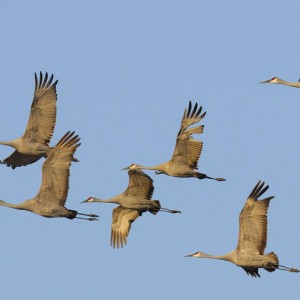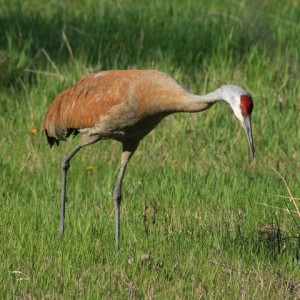By Gayle Pille
NKyTribune Contributor
According to the International Crane Foundation, the Sandhill Crane is the oldest known bird species in the world – some ten million years old. They are also a modern day success story. By 1900 they were almost hunted to extinction, while today they are the most numerous crane species in the world. These long-lived birds can survive more than 25 years in the wild.
There are six species of Sandhill Cranes, three of which are migratory, while the other three are non-migratory. Those passing over our skies are all migratory. The migratory species consist of Lesser, Greater and Canadian Sandhills, with the Lesser Sandhills being the most numerous. They range in size from 3.5-feet tall for Lesser Sandhills to almost 5-feet tall for Greater Sandhills. Migratory Sandhill Cranes nest and rear their young in Northern U.S., Canada, Alaska and Siberia. Each winter these “snowbirds” head south to Florida, Texas and Mexico.

Sandhills are excellent flyers. With their five to seven-foot wingspans, they use thermals to obtain lift and stay aloft. This allows them to expend minimal energy during migration, flapping their wings only occasionally as they ride the air currents for hours on end.
Sandhill Cranes are usually found near wetlands and rivers. They are frequently seen in fields where up to 90-percent of their diet consists of waste corn left over from fall harvest. They provide farmers a service by removing grain that would otherwise become volunteer corn in next year’s crop. These omnivores also eat tubers, snakes, mice, insects and worms.
The “dance” of Sandhills may well be their trademark. They bow, they stretch their wings and leap high into the air, often tossing up a corncob or stick. Most commonly associated with courtship, dancing can occur anytime, anywhere. Dancing is vital to motor development, thwarts aggression and relieves stress, while establishing and strengthening pair bonds.
To the dismay of many birders and conservationists, Kentucky recently legalized hunting of Sandhill Cranes, the first state east of the Mississippi to do so in more than 100 years. Since federally endangered Whooping Cranes migrate with Sandhills (less than 400 Whooping Cranes exist in the wild from a low of only 16 birds in 1942), it is feared that hunters will also kill extremely rare Whooping Cranes, putting further stress on their already low numbers.

Excellent viewing of Sandhill Cranes (and maybe a Whooping Crane) is a mere two-hour drive from Cincinnati near Brownstown, Indiana. Ewing Bottoms, an area of low-lying floodplain and rich agricultural fields, is a gathering spot for thousands of Greater Sandhill Cranes. The cranes can be easily viewed through February.
For further information contact the Cincinati Bird Club at www.cincinnatibirds.com or the Brownstown Chamber of Commerce at secretary@brownstownchamber.org or 812-358-2930. Make a day of it and also visit nearby Muskatatuck National Wildlife Refuge to see a wide variety of waterfowl, raptors and other birds. Contact at 812-522-4352. What better way to spend a winter day?
Gayle Pille is a local naturalist and nature writer who many know through her work to establish the five-mile network of nature trails at Highland Cemetery in Ft. Mitchell. She created the cemetery’s popular 25-year-old Wildlife Enhancement Program and works with a small team of volunteers to maintain the cemetery’s wooded walking paths. An avid birdwatcher, Gayle also builds custom wildlife nest boxes for businesses, parks and residences through her business, www.woodlandhabitat.com
Contact her at gaylepille@yahoo.com
Featured photo by Mike Hollan




















